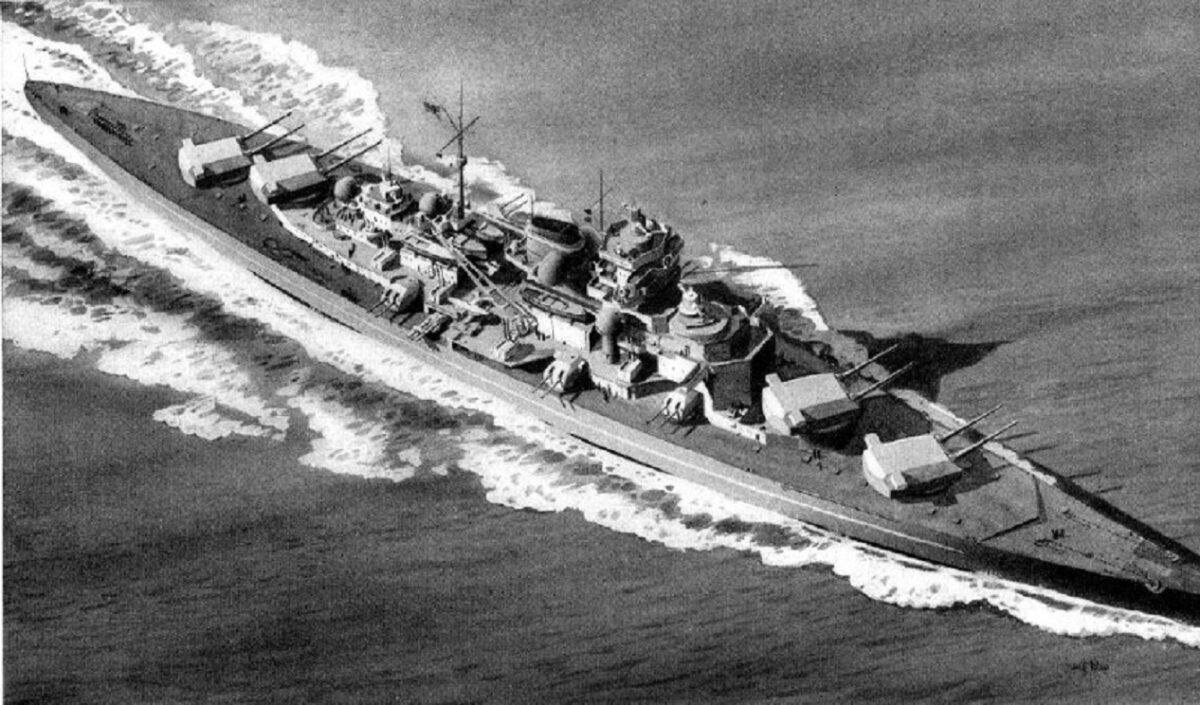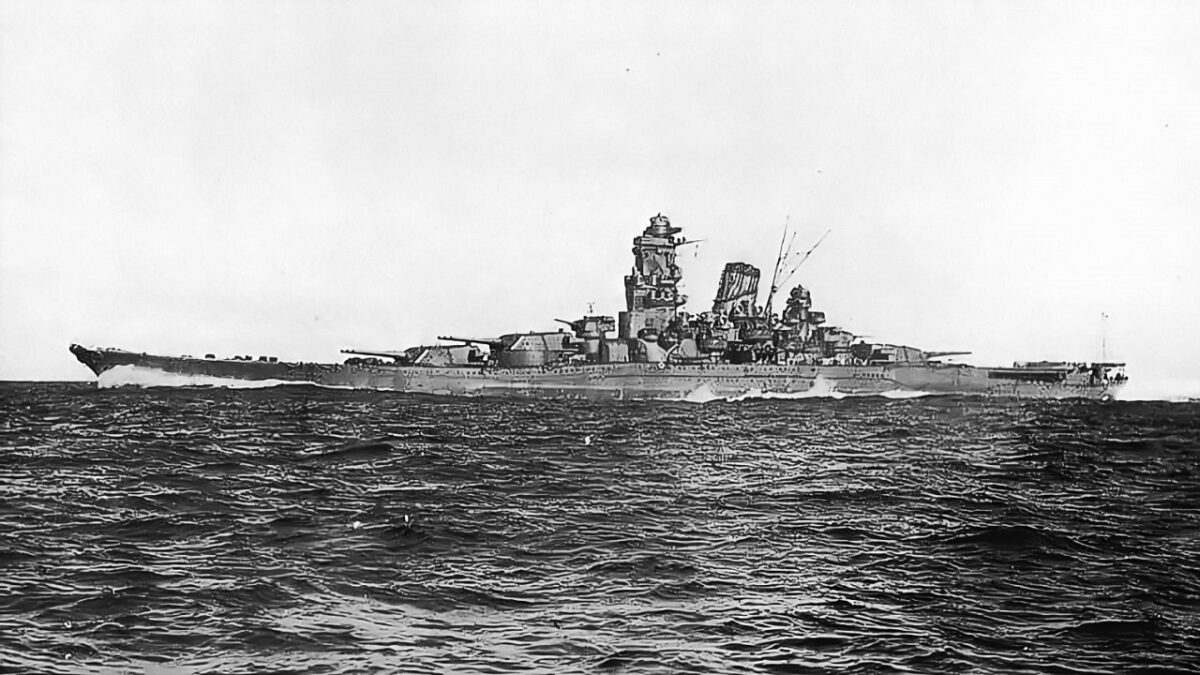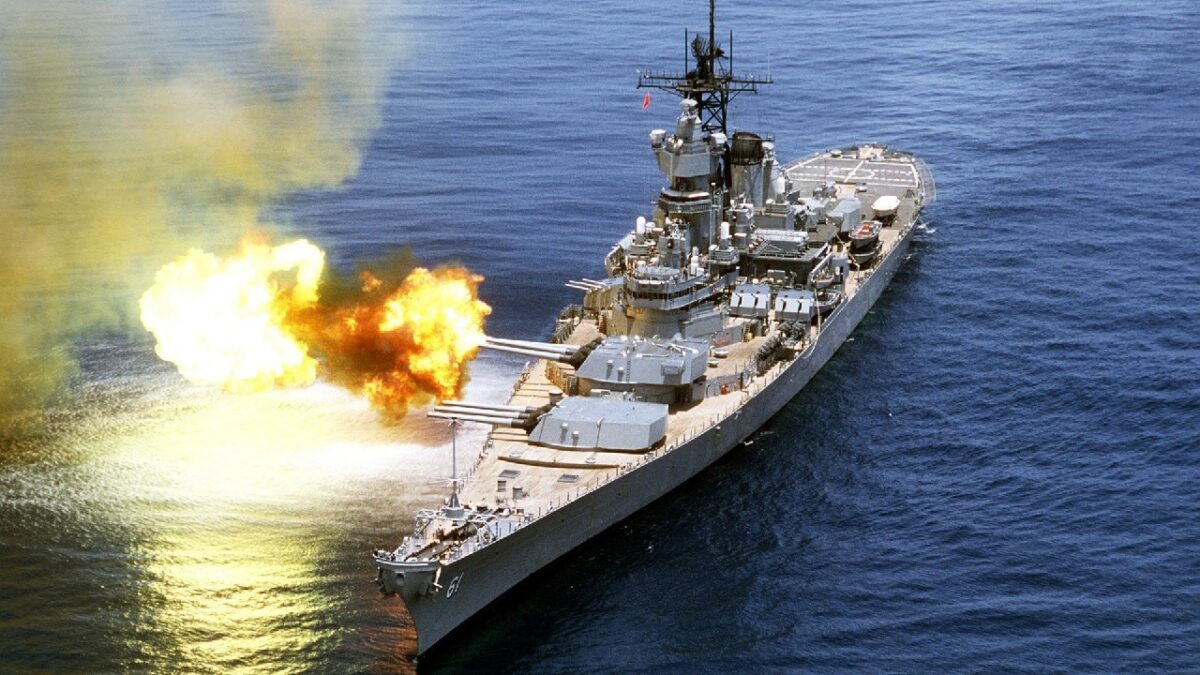Aahh, the good ol’ days of so-called “capital ships,” i.e. battleships.
Their heyday as the dominant form of naval power projection may be long finished, but they enjoyed a magnificent run.
For an old-school battleship enthusiast who readily waxes nostalgic, it’s pretty challenging to narrow down a top-five list of history’s best battlewagons, but “by Jingo”, I’ll give it a try.
5 Best Battleships
The Bismarck
This is the most famous of all German battleships. The Kriegsmarine warship that inspired both a movie that was a box office hit, and a musical single that was an even bigger hit. The Bismarck’s 15-inch guns sank the HMS Hood, the pride of the Royal Navy and its largest largest vessel, in a mere three minutes, leaving only three survivors of out a 1,418-man crew. This ship got Winston Churchill’s personal attention. It required the combined efforts of the HMS Ark Royal’s Fairey Swordfish torpedo bombers and the battleships HMS Rodney and King George V – along with the scuttling charges of the Bismarck’s own crew – to finally sink her. Jawohl, mein Damen und Herren, I dare say the Bismarck easily makes this list.

Image: Creative Commons.
HMS Warspite (Pennant #3)
The overall breadth of HMS Warspite’s wartime accomplishments gives her a slight edge over her British brethren mentioned in the preceding paragraph. As the late maritime historian Peter Mitchell noted:
“During her 32 years of service she had endured bombing, shellfire, ramming, mines and a missile attack, and fought all over the world from Jutland in the Great War, to the Normandy Landings in the Second World War…The Warspite…became known to everyone who served on her as ‘The Grand Old Lady.’”
Particularly impressive was her participation in the Battle of Cape Matapan from March 27-29, 1941, during which she contributed heavily to sinking the Italian heavy cruisers Fiume and Zara, as well as the destroyers Vittorio Alfieri and Giosuè Carducci – thus inflicting what naval historian Vincent P. O’Hara called “Italy’s greatest defeat at sea.”
Sadly, Warspite was sold for scrap in 1947. Fortunately, her chapel door was preserved and donated to The National Museum of the Royal Navy.
USS New Jersey (BB-62)
The U.S. Navy’s Iowa-class battleships were so collectively impressive, it’s hard to narrow them down to just one selection, as a list like this requires. The USS Missouri, AKA “Mighty Mo,” was most famous for hosting Imperial Japan’s surrender. The actual USS Iowa herself was the only one of her class to sink an enemy surface warship.

Iowa-class battleship. Image Credit: Creative Commons.
However, my 1945 colleague Peter Suciu makes a compelling case for USS New Jersey – affectionately known as “The Big J” and “The Black Dragon” – as the best of the bunch:
“BB-62 would prove to be America’s most decorated battleship – earning more battle stars for combat actions than the other three completed Iowa-class warships. USS New Jersey participated in nearly all of the Western Pacific campaigns from her arrival in the theater in January 1944 until the end of the Second World War…In total, USS New Jersey earned nine battle stars for service in the Second World War, four more for Korea, three for the Vietnam War, and three for actions in Lebanon and the Persian Gulf Region. The warship had also received the Navy Unit Commendation for Vietnam service, as well as the Presidential Unit Citation from the Republic of the Philippines, and the Presidential Unit Citation from the Republic of Korea.”

30 Sep 1968 — The battleship USS New Jersey fires its 16-inch guns into the demilitarized zone here 9/30. These were the first shells fired by the New Jersey in the Vietnamese war. The vessel is the only battleship on active duty in the U.S. Navy.

The Nos. 1 and 2 Mark 7 16-inch/50-caliber guns are fired to starboard during a main battery firing exercise aboard the battleship USS NEW JERSEY (BB-62).
The Big J last fired her guns in anger during the Lebanon crisis of 1983-1984. She is now a museum ship in Camden, New Jersey.
USS Washington (BB-56)
The North Carolina-class battlewagon USS Washington has a bragging right that none of the Iowas can lay claim to: sinking an enemy battleship, and for good measure, scoring the only one-on-one battleship kill of the war. (And to address our loyal reader Frank Benton’s assertion that “the Bismarck single-handedly sunk the HMS Hood in World War II,” sorry, but nope; Bismarck had some assistance from the Prinz Eugen.)

USS Washington (BB-56) running post-overhaul trials in Puget Sound, Washington, on 10 September 1945.
Washington’s victim was the IJN Kirishima (霧島), and a big reason for this achievement – which took place on Nov. 14-15, 1942 –was the fighting prowess of then-Rear Adm. Willis Augustus “Ching” Lee Jr, who, as noted by biographer Paul Stillwell, was an incredible marksman in everything from small arms all the way up to battleship guns.
The Admiral Graf Spee
We started this piece with a Kriegsmarine vessel, so how poetic that we conclude with one as well. Dubbed a “pocket battleship” by the British – the ship’s 11-inch guns were larger than the 8-inchers typical of heavy cruisers but significantly smaller than those of full-sized battleships – the Graf Spee was the centerpiece during the Battle of River Plate, the first major naval engagement of WWII. Between September and December 1939, she sank 11 Allied merchant ships before a relentless Royal Navy pursuit culminated in her scuttling off Montevideo, Uruguay.

Graf Spree Pocket Battleship. Image Credit: Creative Commons.
Agree or Disagree?
Okay, dear readers, whaddya think? I imagine the Yamato and Musashi fans in particular will have some grumblings. Fire away (pun intended).

Yamato-Class Battleship/Artist Rendition. Image Credit: Creative Commons.

Yamato-class battleship Yamato.
Bonus: Meet the Iowa-Class Battleship

Image is of an Iowa-class battleship. Image Credit: Creative Commons.

USS Iowa Battleship. Image Credit: Creative Commons.

Image of Iowa-class battleships firing her 16-inch guns. Image Credit: Creative Commons.

An aerial starboard bow view of the battleship USS IOWA (BB 61) firing a 2,700-pound projectile from the barrel of a forward 16-inch gun during sea trials off the coast of Mississippi. The IOWA is scheduled to be recommissioned into the fleet on April 28, 1984, after completion of modernization/reactivation construction at Ingalls Shipbuilding, Pascagoula, Mississippi.

Battleship USS Iowa. Image Credit: Creative Commons.
MORE: World War III – Where Could It Start?
MORE: A U.S.-China War Over Taiwan Would Be Bloody
Christian D. Orr is a former Air Force Security Forces officer, Federal law enforcement officer, and private military contractor (with assignments worked in Iraq, the United Arab Emirates, Kosovo, Japan, Germany, and the Pentagon). Chris holds a B.A. in International Relations from the University of Southern California (USC) and an M.A. in Intelligence Studies (concentration in Terrorism Studies) from American Military University (AMU). He has also been published in The Daily Torch and The Journal of Intelligence and Cyber Security. Last but not least, he is a Companion of the Order of the Naval Order of the United States (NOUS). In his spare time, he enjoys shooting, dining out, cigars, Irish and British pubs, travel, USC Trojans college football, and Washington DC professional sports.

